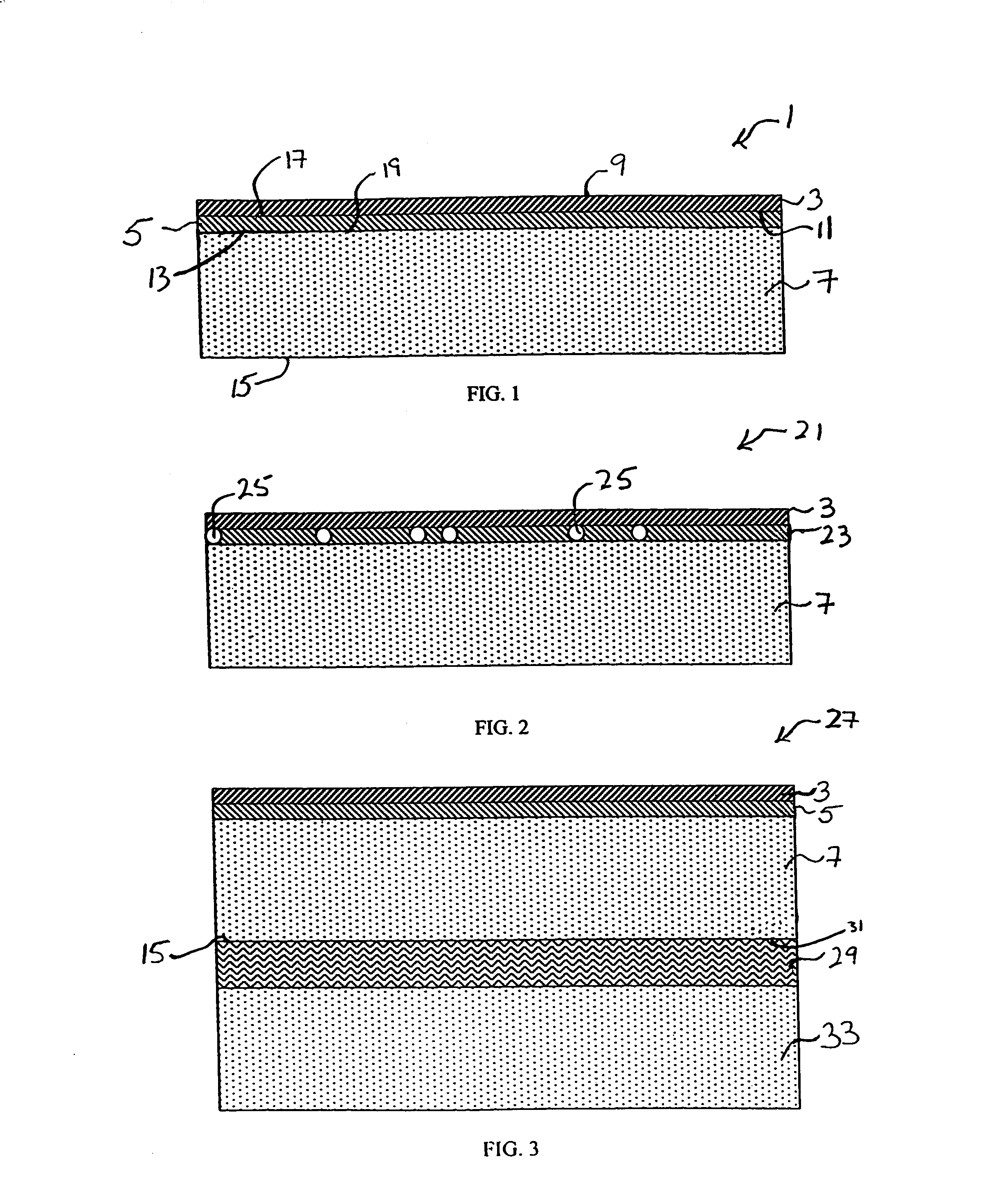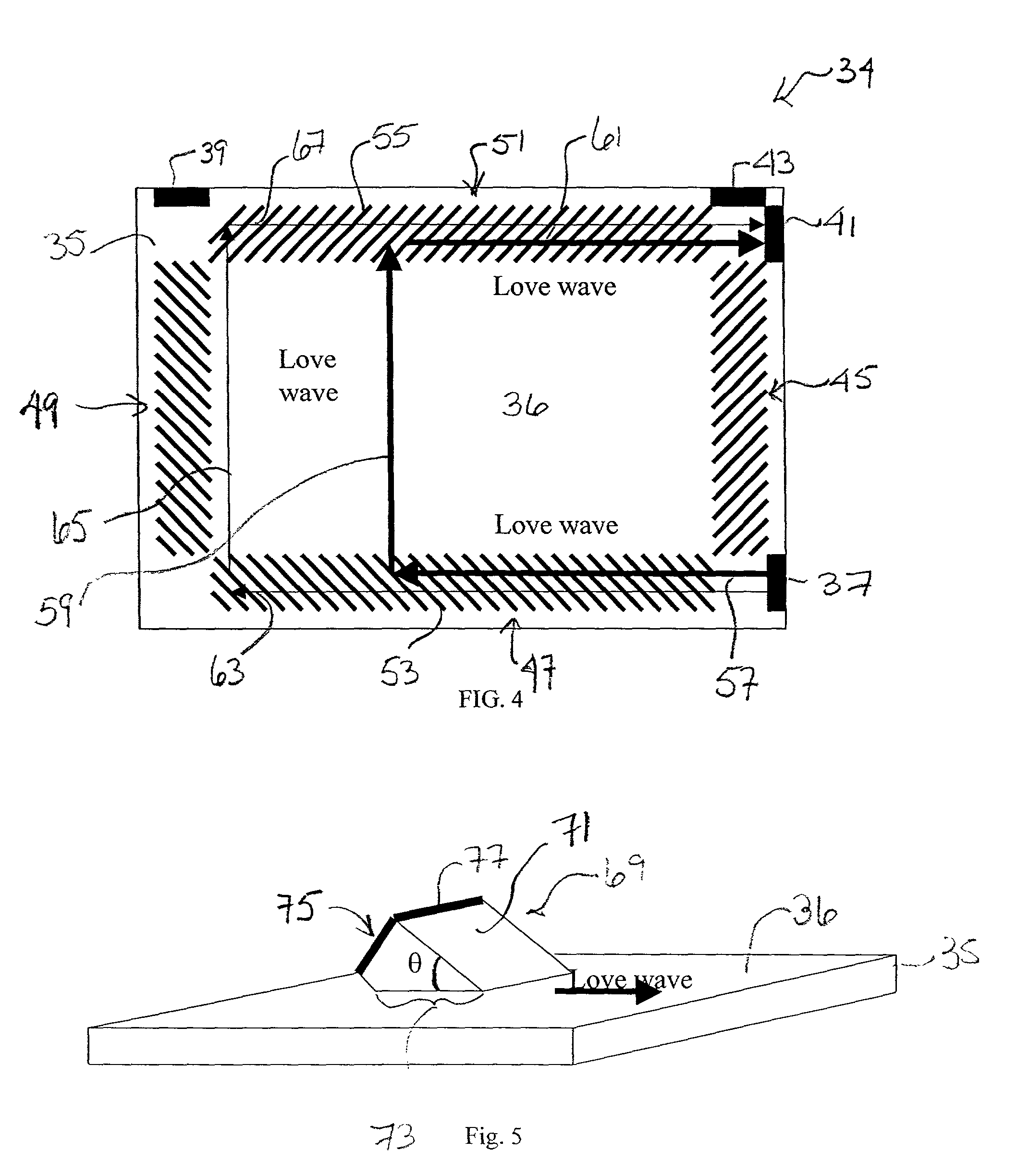Acoustic touch sensor with laminated substrate
a touchscreen and touchscreen technology, applied in the field of multi-layer touchscreen substrates, can solve the problems of inconvenient use, rayleigh waves, drawbacks, etc., and achieve the effects of reducing substrate insensitivity, increasing substrate sensitivity, and reducing thickness
- Summary
- Abstract
- Description
- Claims
- Application Information
AI Technical Summary
Benefits of technology
Problems solved by technology
Method used
Image
Examples
example 1
[0056]Three-layer touchscreen substrates of the present invention shown in FIG. 1 were constructed using all three microsheets in Table 1, a 3 mm thick sheet of soda-lime glass for the plate 7, and a 32 micron thick sheet of polystyrene. One side of the microsheet 3 and one side of the plate 7 were each dipped into a 0.1% azido sulfonate silane methyl ethyl ketone (MEK) coating solution. Alternatively, it is contemplated that the entire polymer sheet could be dipped into the silane coating solution. The microsheet and the plate were then air-dried and cured in an oven at 110° C. for a sufficient time to covalently bond the silane molecules to the glass microsheet and plate. During the drying process, solvent in the coating solution is evaporated off leaving a silane coating a few molecules thick on the microsheet and plate. The thickness of the silane coating is negligible, and therefore, does not add to the thickness of the substrate. Subsequently, the layers of the touchscreen sub...
example 2
[0067]Destructive impact strength tests were performed on touchscreen substrates made according to the process set forth in Example 1. The touchscreen substrates were made from a 100 micron thick Schott D-263 microsheet, a 32 micron thick polystyrene sheet, and a 3 mm thick soda-lime glass plate. The soda-lime glass plate had dimensions of approximately 19 cm×24 cm, with the microsheet and polystyrene sheet being slightly smaller than the plate. A 5 cm diameter steel ball was dropped from increasing heights on each of the two samples. The drop height started at 15 cm and was increased in 5 cm increments. Both samples survived the impact of the falling steel ball with no visible effects until a drop height of 40 cm was reached. Both samples failed at 40 cm. Interestingly, the failure appeared to be in the 3 mm thick soda-lime glass plate, not the 100 micron thick glass microsheet. Fractured shards of the 3 mm thick glass plate remained bonded to the polystyrene sheet which remained b...
example 3
[0069]FIG. 2 illustrates another embodiment of a touchscreen substrate of the present invention. The substrate 21 comprises a microsheet 3 and a plate 7 as shown in FIG. 1. The intermediate sheet 23, however, is not a separate flexible polymer sheet as described in Example 1. Rather, the intermediate polymer sheet 23 is formed by in situ polymerization.
[0070]An uncured polymer base material is formed into a polymer precursor. The polymer precursor may comprise, but is not limited to, polystyrene, polyacrylate, polyether sulfones, polycyclic olefins, or combinations thereof, and may be a liquid or a liquid with fillers. In a preferred embodiment, the polymer precursor is a polyacrylate based liquid system. Such polyacrylate systems have good bonding properties, are inexpensive, have high environmental resistance, and have high light transparency. Moreover, a separate coupling agent is not necessary to achieve bonding of the substrate layers with an acrylic based system.
[0071]In order...
PUM
 Login to View More
Login to View More Abstract
Description
Claims
Application Information
 Login to View More
Login to View More - R&D
- Intellectual Property
- Life Sciences
- Materials
- Tech Scout
- Unparalleled Data Quality
- Higher Quality Content
- 60% Fewer Hallucinations
Browse by: Latest US Patents, China's latest patents, Technical Efficacy Thesaurus, Application Domain, Technology Topic, Popular Technical Reports.
© 2025 PatSnap. All rights reserved.Legal|Privacy policy|Modern Slavery Act Transparency Statement|Sitemap|About US| Contact US: help@patsnap.com



